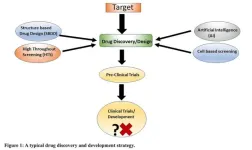(Press-News.org)
Methods commonly used to measure poverty can lead to vastly different conclusions about who actually lives in poverty, according to a new Stanford University-led study. Based on household surveys in sub-Saharan Africa, the first-of-its-kind analysis, published Feb. 5 in Proceedings of the National Academy of Sciences, underscores the importance of accurately defining and measuring poverty. Its findings could help inform how governments, nonprofit organizations, and international development agencies allocate resources and evaluate the effectiveness of poverty-alleviation policies around the world.
“They say you can’t manage what you don’t measure,” said study senior author Eric Lambin, the George and Setsuko Ishiyama Provostial Professor in the Stanford Doerr School of Sustainability and senior fellow at the Stanford Woods Institute for the Environment.
“In our study, we find how one chooses to measure poverty can completely change the extent to which programs and policies are managed and reach vulnerable populations,” said study lead author Christine Pu, a PhD student in environmental engineering at the Stanford Doerr School of Sustainability.
Comparing definitions
Governments around the world want to support households living in poverty, but it’s not always easy to determine which households need help. For example, two U.S. families of the same size could be classified as poor – and eligible for public support programs like food assistance and subsidized utility services – because their annual income is less than the federal $31,200 poverty guideline. In actuality, the families might have dramatically different overall costs or assets. For example, one might own their home and two cars, while the other might rent their home and depend on public transportation.
The study examined four widely used poverty measurement approaches. Each metric is based on different priorities ranging from reported assets, such as appliances, to self-defined well-being milestones, such as being able to send children to school. Working with colleagues in Ethiopia, Ghana, and Uganda, the Stanford researchers surveyed 16,150 households. Surprisingly, the research revealed almost no agreement in how these approaches ranked households by poverty status. The lack of agreement persisted even among households classified in the bottom 20% in terms of poverty.
Even after controlling for geographic variability, the study found weak correlations between the measurement approaches, indicating that the discrepancies were not simply due to regional differences. The differences in relative rankings were not small either. On average, households’ poverty rankings differed by 25 percentage points. In other words, a household ranked in the 25th percentile by one measurement might be ranked as the most impoverished household or as the median household by another measurement.
“Organizations that adopt a measurement approach without reflecting on how it fits their conception of poverty are, at best, rolling the dice about creating classifications of households that work in alignment with their mission and objectives,” the researchers write. “At worst, these organizations are adopting methodologies that may be wholly inappropriate for their poverty alleviation goals.”
Choosing wisely
One striking example of this conceptual misalignment is the U.S. government’s Demographic and Health Survey (DHS) Program wealth index. The index was designed to explain disparities in health outcomes. However, it is widely used to represent a household’s poverty status. This application can lead to counterintuitive rankings of households. For example, whereas most rural development specialists would consider livestock ownership to be a sign of family wealth, the DHS index lowers the rankings of households for every additional livestock unit that they own because rural households that own livestock typically have limited access to health services.
Given the widespread influence of the DHS wealth index, this measurement problem is being propagated and amplified through many applications and decision-making processes. The issue is not unique to the DHS wealth index, but emblematic of a larger problem embedded in many indices and measurement tools.
Overall, the findings suggest that the choice of a measurement approach can lead to very different conclusions about who qualifies for poverty alleviation programs and policies, and how much these efforts achieve. The authors argue that organizations should carefully consider their definition of poverty and select measurement approaches that align with their specific objectives.
Additional Stanford co-authors include Jenna Davis, associate dean for integrative initiatives in institutes and international partnerships, professor of civil and environmental engineering, Higgins-Magid Senior Fellow at the Stanford Woods Institute for the Environment, and director of the Stanford Program on Water, Health & Development. Additional co-authors are from the International Growth Research and Evaluation Center in Uganda, Addis Ababa University in Ethiopia, and Kwame Nkrumah University of Science and Technology in Ghana.
The study was funded by the Stanford King Center on Global Development, the Conrad N. Hilton Foundation, the Natural Science and Engineering Council of Canada, the Stanford Interdisciplinary Graduate Fellowship, and the Charles H. Leavell Fellowship.
-30-
END
The workings of the ultrasonic warning sounds produced by the wings of a species of moth have been revealed by researchers at the University of Bristol.
Scientists recently discovered that moths of the genus Yponomeuta (so-called ermine moths) have evolved a very special acoustic defence mechanism against their echolocating predators—bats.
Ermine moths produce ultrasonic clicking sounds twice per wingbeat cycle using a minute corrugated membrane in their hindwing. Strikingly, these moths lack hearing organs and are therefore not aware of their unique defence mechanism, nor do they have the capability to control it using muscular ...
A new analysis by MIT researchers shows the places in the U.S. where jobs are most linked to fossil fuels. The research could help policymakers better identify and support areas affected over time by a switch to renewable energy.
While many of the places most potentially affected have intensive drilling and mining operations, the study also measures how areas reliant on other industries, such as heavy manufacturing, could experience changes. The research examines the entire U.S. on a county-by-county level.
“Our result ...
THIS PRESS RELEASE IS EMBARGOED UNTIL FEBRUARY 5, 2024 at 3:00 PM U.S. EASTERN TIME
Many Indigenous peoples and local communities around the world are leading very satisfying lives despite having very little money. This is the conclusion of a study by the Institute of Environmental Science and Technology of the Universitat Autònoma de Barcelona (ICTA-UAB), which shows that many societies with very low monetary income have remarkably high levels of life satisfaction, comparable to those in wealthy countries.
Economic growth is often prescribed as a sure way of increasing the well-being of people in low-income countries, and ...
Many neurodegenerative diseases, including Alzheimer’s and Parkinson’s, are difficult to diagnose before symptoms begin to appear. However, disease-related biomarkers such as aggregated proteins called amyloids could provide important insight much earlier, if they can be readily detected. Researchers publishing in ACS Sensors have developed one such method using an array of sensor molecules that can light up amyloids. The tool could help monitor disease progression or distinguish between different ...
Janelia scientists and longtime collaborators Eric Betzig and Harald Hess will be inducted into the 2024 class of the National Inventors Hall of Fame for their invention of photoactivated localization microscopy (PALM), a pioneering imaging technology that enables scientists to image live cells in super-resolution to study biological structures and processes in unprecedented detail.
Betzig, a senior fellow at Janelia and an HHMI Investigator at the University of California, Berkeley, and Hess, a senior ...
Violence spreads in a contagious way like a disease among members of the Italian mafia, a new study shows.
Researchers have found committing violent acts with others increases the likelihood people in these groups will go on to carry out more violent offences in the future.
The analysis of the criminal careers of organised crime offenders shows previous violence has a “persistent and long-lasting” impact on their behaviour.
Prior violent co-offending has a greater impact than prior violent solo offending on the probability of future violence. Prior violent co-offending increases the probability ...
Petrina Kamya, PhD, Head of AI Platforms and President of Insilico Medicine Canada, will present at the BIO CEO & Investor Conference happening Feb. 26-27 at the New York Marriott Marquis in New York City. Dr. Kamya will speak as part of the panel “AI within Biopharma: Separating Value from Hype,” on Feb. 27, 1pm ET along with Michael Nally, CEO of Generate: Biomedicines and Liz Schwarzbach, PhD, CBO of BigHat Biosciences.
The session will look at how the latest artificial intelligence (AI) tools – including generative AI and large language models – ...
“[...] fruitful efforts to bring more drugs from bench to bedside could only be possible if we do not leave them ‘midway’!”
BUFFALO, NY- February 5, 2024 – A new editorial paper was published in Oncotarget's Volume 15 on January 24, 2024, entitled, “The fate of drug discovery in academia; dumping in the publication landfill?”
In this new editorial, researchers Uzma Saqib, Isaac S. Demaree, Alexander G. Obukhov, Mirza S. Baig, Amiram Ariel, and Krishnan Hajela, from Devi Ahilya Vishwavidyalaya, Indore, discuss drug discovery—a tedious process that is time consuming in both divulging whether a molecule is efficacious and specific in hitting ...
In a warming climate, meltwater from Antarctica is expected to contribute significantly to rising seas. For the most part, though, research has been focused on West Antarctica, in places like the Thwaites Glacier, which has seen significant melt in recent decades.
In a paper published Jan. 19 in Geophysical Research Letters, researchers at Stanford have shown that the Wilkes Subglacial Basin in East Antarctica, which holds enough ice to raise global sea levels by more than 10 feet, could be closer to runaway melting than anyone realized.
“There hasn’t been much analysis in this region – there’s huge ...
Gastrointestinal cancers (GCs) are among the most common forms of cancer and account for as much as one-third of all cancer deaths worldwide. Early diagnosis is an effective way of reducing the mortality associated with GCs, and endoscopic screening has proved to be an excellent approach for detecting potentially malignant tumors.
To extend the benefits of screening programs to as many people as possible, the imaging systems used should be inexpensive to manufacture and operate, yet accurate enough ...




